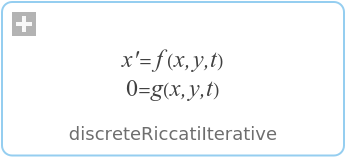WOLFRAM SYSTEM MODELER
discreteRiccatiIterativeNewton's method with exact line search for solving discrete algebraic Riccati equation |
|
Wolfram Language

SystemModel["Modelica.Math.Matrices.Utilities.discreteRiccatiIterative"]

Information
This information is part of the Modelica Standard Library maintained by the Modelica Association.
Syntax
X = Matrices.Utilities.discreteRiccatiIterative(A, B, R, Q, X0);
(X, r) = Matrices.Utilities.discreteRiccatiIterative(A, B, R, Q, X0, maxSteps, eps);
Description
This function provides a Newton-like method for solving discrete-time algebraic Riccati equations. It uses Exact Line Search to improve the sometimes erratic
convergence of Newton's method. Exact line search in this case means, that at each iteration i a Newton step delta_i
X_i+1 = X_i + delta_i
is taken in the direction to minimize the Frobenius norm of the residual
r = || A'X_i+1*A - X_i+1 - A'X_i+1*G_i*X_i+1*A + Q ||
with
-1
G_i = B*(R + B'*X_i*B) *B'
Output r is the norm of the residual of the last iteration.
The inputs "maxSteps" and "eps" specify the termination of the iteration. The iteration is terminated if either maxSteps iteration steps have been performed or the relative change delta_i/X_i became smaller than eps.
With an appropriate initial value X0 a sufficiently accurate solution might be reach with a few iteration steps. Although a Lyapunov equation of
order n (n is the order of the Riccati equation) is to be solved at each iteration step, the algorithm might be faster
than a direct method like Matrices.discreteRiccati, since direct methods have to solve the 2*n-order Hamiltonian
system equation.
The algorithm is taken from [1] and [2].
References
[1] Benner, P., Byers, R.
An Exact Line Search Method for Solving Generalized Continuous-Time Algebraic Riccati Equations
IEEE Transactions On Automatic Control, Vol. 43, No. 1, pp. 101-107, 1998.
[2] Datta, B.N.
Numerical Methods for Linear Control Systems
Elsevier Academic Press, 2004.
Example
A = [0.9970, 0.0000, 0.0000, 0.0000;
1.0000, 0.0000, 0.0000, 0.0000;
0.0000, 1.0000, 0.0000, 0.0000;
0.0000, 0.0000, 1.0000, 0.0000];
B = [0.0150;
0.0000;
0.0000;
0.0000];
R = [0.2500];
Q = [0, 0, 0, 0;
0, 0, 0, 0;
0, 0, 0, 0;
0, 0, 0, 1];
X0=identity(4);
(X,r) = Matrices.Utilities.discreteRiccatiIterative(A, B, R, Q, X0);
// X = [30.625, 0.0, 0.0, 0.0;
0.0, 1.0, 0.0, 0.0;
0.0, 0.0, 1.0, 0.0;
0.0, 0.0, 0.0, 1.0];
// r = 3.10862446895044E-015
See also
Matrices.Utilities.continuousRiccatiIterativeMatrices.discreteRiccati
Syntax
Inputs (7)
| A |
Type: Real[:,size(A, 1)] Description: Matrix A of discrete Riccati equation |
|---|---|
| B |
Type: Real[size(A, 1),:] Description: Matrix B of discrete Riccati equation |
| R |
Default Value: identity(size(B, 2)) Type: Real[size(B, 2),size(B, 2)] Description: Matrix R of discrete Riccati equation |
| Q |
Default Value: identity(size(A, 1)) Type: Real[size(A, 1),size(A, 2)] Description: Matrix Q of discrete Riccati equation |
| X0 |
Default Value: identity(size(A, 1)) Type: Real[size(A, 1),size(A, 2)] Description: Initial approximate solution discrete Riccati equation |
| maxSteps |
Default Value: 10 Type: Integer Description: Maximal number of iteration steps |
| eps |
Default Value: Matrices.frobeniusNorm(A) * 1e-9 Type: Real Description: Tolerance for stop criterion |
Outputs (2)
| X |
Type: Real[size(X0, 1),size(X0, 2)] |
|---|---|
| r |
Type: Real |
Revisions
- 2010/04/30 by Marcus Baur, DLR-RM
